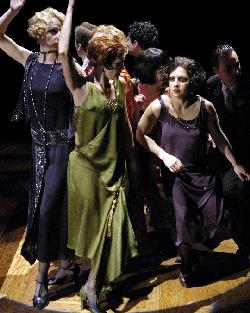SEARCH CurtainUp
REVIEWS
FEATURES
NEWS
Etcetera and
Short Term Listings
LISTINGS
Broadway
Off-Broadway
BOOKS and CDs
OTHER PLACES
Berkshires
London
LA/San Diego
Philadelphia
Elsewhere
QUOTES
On TKTS
LETTERS TO EDITOR
FILM
LINKS
MISCELLANEOUS
Free Updates
Masthead
NYC Weather
 Review
Review
Intimations for Saxophone
by Sam Thielman
 S. Lynskey, S. Hightower and M. Spielman
(Photo: Scott Suchman) |
For a piece about a woman seeking the satisfaction missing from her marriage, it's surprising how sharp and up-tempo Intimations for Saxophone remains. The actors break into marvelous dance between scenes, jitterbugging with the critical lightness needed to keep Treadwell's subjects afloat.
Barney O'Hanlon walks Lily's childish husband Gilly along the thin line between haplessness and hopelessness. Even as a needy, infantile fool, Gilly retains his naïveté, and it's very hard not to feel sorry for him when Lily leaves.
Lily is intelligent and honest, but also fully human, and Treadwell does her the service of suggesting that she be held responsible for her marriage as much as Gilly. Lily is seen not only engaging in an affair, but actually learning from it, and exhibiting a better knowledge of human nature in the future. "Sadder But Wiser Housewives," perhaps.
The staging represents the void that Lily feels in a variety of ways, but none more effective than the stage itself. When the setting is her house, it rises to form a square walkway with an unlit, lowered center. When Gilly asks her why she must always have the saxophone music playing, she says simply, "It fills in." "Fills in what?" he asks, but he doesn't get an answer. At the beginning of the play Lily doesn't like the sax at all, musing that it sounds "so hungry, and lonely, and so empty." But there's a reason that the music makes her uncomfortable: they're playing her song.
The sound design, too, serves the script well. The jazz music seems picked to underscore the themes of the play, rather than giving the dramatic moments a little push a la film. When Lily dances by herself in her room, alone and damaged, the music is a bitter, growly solo. When she dances in a group, a full band plays a lighter melody.
Bogart has stripped the stage of all props except a few nightclub tables and small lamps, increasing the spacious performance area to accommodate the wide variety of roles written for her actors -- the glamorous part of the bureau, for example, or the breakout character of the sink. All of the set pieces that are not tables or chairs are formed by actors alone or in conjunction with one another, making boats and closets and furniture.
The play is understandably dated -- Freudian theory shows up unquestioned a few times, and occasionally the jokes don't quite work. Bogart, however, seems to understand the play's flaws and works hard to compensate for them. The surrealism of the staging works wonders against the stark reality of the situation in the script, retaining a sort of Virginia Woolfish quality in the midst of a lot of good jazz and Barney O'Hanlon's limber choreography.
Above all, Bogart polishes the similarities between the Jazz Age and our own, making clear the universality of Lily's predicament, and the difficulty of life in general; life with someone else in particular. Bogart and Treadwell dance enlightenment at breakneck speed and rarely miss a step; their play is a wonder to behold, and not merely for the decades-long gap in their collaboration.
Editor's Note: For a review of a revival of Treadwell's well known Machinal, go here.
|
Intimations for Saxophone by Sophie Treadwell Directed by Anne Bogart with Akiko Aizawa, Shawn Fagan, Gian-Murray Gianino, Karron Graves, Susan Hightower, Marcus Kyd, Susan Lynskey, Christopher McCann, Barney O'Hanlon, and Makela Spielman Dramaturg: Michael Kinghorn Dances: Barney O'Hanlon Soundscape: Darron L. West Lighting Design: Christopher Akerlind Costume Design: James Schuette Set Design: Neil Patel Running Time: 1 hour, 45 minutes with intermission Arena Stage, 1101 6 Street SW Telephone: 202.554.9066 TUE, WED, SUN @7:30; THU, FRI, SAT @8:00; SUN @2:00 Opening 01/27/05, closing 02/27/05 Reviewed by Sam Thielman based on 01/27/05 performance |

Easy-on-the budget super gift for yourself and your musical loving friends. Tons of gorgeous pictures.

Retold by Tina Packer of Shakespeare & Co.
Click image to buy.
Our Review

At This Theater

Leonard Maltin's 2005 Movie Guide

Ridiculous!The Theatrical Life & Times of Charles Ludlam

6, 500 Comparative Phrases including 800 Shakespearean Metaphors by CurtainUp's editor.
Click image to buy.
Go here for details and larger image.



